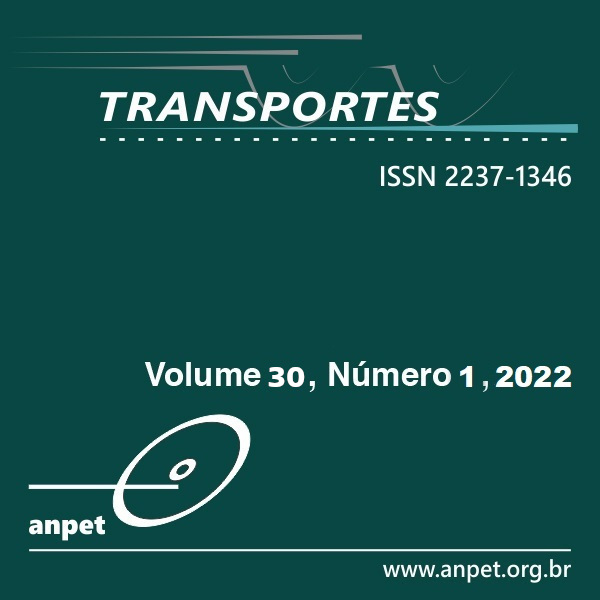Ranking of the best binders to be applied in the bituminous priming of roads according to technological and environmental characteristics
DOI:
https://doi.org/10.14295/transportes.v30i1.2576Keywords:
Paving, Primer, Sustainability, CM-30Abstract
The search for understanding the behavior of less polluting binders when compared to diluted petroleum asphalt (CM-30) for the priming service motivated this research. Thus, commercial and alternative binders applicable in priming services were ranked by technological and environmental criteria. To do so, the following parameters were checked: penetration, cohesion, adherence, surface wear, and environmental
parameters of bases primed with different soils, using CM-30 as reference and six
alternative binders: G8, G14, G15, G17, G18, and a special emulsion for priming - E1.
In the sandy base, the type of fluid predominated over the parameters evaluated. On the clayey base, variations in humidity altered these parameters. Thus, G14 showed promise against CM-30, followed by the binders G8 and G18. However, the G18 binder proved to be unfeasible due to the energy expenditure for its application, around 120°. In the environmental analysis, G8 emitted less volatiles than CM-30, being technically and environmentally more self-sustainable.
Downloads
References
ABNT (2019) ABNT NBR 13528-3: Revestimento de paredes de argamassas inorgânicas - Determinação da resistência de aderência à tração Parte 3: Aderência superficial. Rio de Janeiro, Associação Brasileira de Normas Técnicas, Comissão de Estudo de Asfalto.
ABNT (2014) ABNT NBR 14746: Microrrevestimentos a frio e lama asfáltica - Determinação de perda por abrasão úmi-da (WTAT). Rio de Janeiro, Associação Brasileira de Normas Técnicas, Comissão de Estudo de Asfalto.
Almeida, F. D.; S. A. R. Lima Filho; S. H. A. Barroso e J. B. S. Bastos (2014) Desenvolvimento de um método expedito para avali-ação da imprimação betuminosa de rodovias. In: Instituto Brasileiro de Petróleo, Gás e Biocombustíveis - IBP, 21º Encontro de Asfalto - IBP357_14.
Almeida, F. D.; S. A. Torquato e Silva; S. H. A. Barroso, e J. B. Soares (2016) Aplicação do Ensaio de Arrancamento por Torção para Avaliação da Aderência de Bases Imprimadas. XXX Congresso de Pesquisa e Ensino em Transportes – ANPET, Rio de Janei-ro-RJ.
Almeida, F. D. e S. H. A. Barroso (2017) Avaliação Da Coesão Da Imprimação Betuminosa De Rodovias. 2017, Congresso Ibero Latinoamericano del Asfalto – 0144, Medellin, Colômbia.
Almeida, F. D. e S. H. A. Barroso (2019) Avaliação da penetração do ligante asfáltico e o desgaste superficial de bases imprimadas. XXXIII Congresso de Pesquisa e Ensino em Transportes – ANPET, Balneário Camboriú-SC.
AI (2020) AI MS-22: Construction of Hot Mix Asphalt Institute. Third Edition.The Asphalt Institute, Lexington - KY.
ASTM (2005) ASTM D92: Standard Test Method for Flash and Fire Points by Cleveland Open Cup Tester.
ASTM (2021) ASTM D8-21: Standard Terminology Relating to Materials for Roads and Pavements. ASTM International, West Conshohocken, PA.
Bernucci, L. L. B.; L. M. G. Motta; J. A. P. Ceratti e J. B. Soares (2010) Pavimentação Asfáltica - Formação Básica para Engenhei-ros. Rio de Janeiro-RJ: Petrobras: ABEDA.
Boczkaj, G.; A. Przyjazny e M. Kamin (2014) Chemosphere Characteristics of volatile organic compounds emission profiles from hot road bitumens. Chemosphere v. 107, p. 23–30. DOI: 10.1016/j.chemosphere.2014.02.070
Cargnin, R. S.; P. C. Nascimento; L. M. Ferraz; M. M. Barrichello; L. C. Brudi; M. B. Rosa; L. M. Carvalho; D. B. Nascimento; M. C. Cravo e L. A. H. Nascimento (2017) Investigation of extraction and collection of polycyclic aromatic hydrocarbons from aqueous solutions at different temperatures. Polycyclic Aromatic Compounds. DOI: 10.1080/10406638.2017.1353529.
Brudi, L. C.; F. R. Adolfo; P. C. Nascimento; P. Schmidt; R. S. Cargnin; D. Bohrer; L. M. Carvalho e L. A. H Nascimento, (2021) Emissão e coleta de hidrocarbonetos aromáticos policíclicos de amostras de asfalto bruto aquecido a 130 ° C. Energia e com-bustíveis , 34 (9), 11248-11257.
Castro, C. A. A. (2003) Estudo da técnica de anti-pó com emulsão de xisto em pavimentos para baixo volume de tráfego. Tese de M. Sc., Programa de Engenharia Civil, COPPE/UFRJ, Rio de Janeiro-RJ.
Dantas, J. M. (1959) Tratamentos contra o pó, imprimações, pinturas de ligação, tratamentos superficiais, macadames betumino-sos. Curso de Especialização Rodoviária. Instituto de Pesquisas Rodoviárias.
Dantas Neto (2001) Materiais asfálticos alternativos para uso em pavimentação. Dissertação de Mestrado. Universidade de Brasília, Faculdade de Tecnologia, Departamento de Engenharia Civil e Ambiental, Brasília - DF.
DNIT (2006) DNIT PRO-070: Condicionantes ambientais das áreas de uso de obras. DPP/IPR, Rio de Janeiro-RJ.
DNIT (2018) DNIT ME-134: Pavimentação - Solos - Determinação do módulo de resiliência. DPP/IPR, Rio de Janeiro-RJ.
DNIT (2014) DNIT ES-144: Pavimentação - Imprimação com ligante asfáltico. Rio de Janeiro-RJ.
DNER (1999) Diretrizes básicas para elaboração de estudos e projetos rodoviários (escopos básicos/instruções de serviço). - Rio de Janeiro-RJ, IPR. Publ., 707.
DNIT (1994) DNIT ME-041: Solos - Preparação de Amostras para ensaios de caracterização - MT - Instituto de Pesquisas Ro-doviárias. Rio de Janeiro-RJ.
DNIT (1994) DNIT ME-049: Índice de Suporte Califórnia de Solos Utilizando Amostras não Trabalhadas - MT - Instituto de Pesquisas Rodoviárias. Rio de Janeiro-RJ.
DNIT (1994) DNIT ME-051: Análise Granulométrica por Sedimentação - MT - Instituto de Pesquisas Rodoviárias. Rio de Janeiro-RJ.
DNIT (1994) DNIT ME-080: Análise Granulométrica por Peneiramento - MT - Instituto de Pesquisas Rodoviárias. Rio de Janeiro-RJ.
DNIT (1994) DNIT ME-082: Solos - Determinação do Limite de Plasticidade - MT - Instituto de Pesquisas Rodoviárias. Rio de Janeiro-RJ.
DNIT (1994) DNIT ME-093: Solos - Determinação de Densidade Real - MT - Instituto de Pesquisas Rodoviárias. Rio de Janeiro-RJ.
DNIT (1994) DNIT ME-122: Determinação do Limite de Liquidez de Solos - MT - Instituto de Pesquisas Rodoviárias. Rio de Janeiro-RJ.
DNIT (1994) DNIT-ME-162: Solos - Ensaio de compactação utilizando amostras trabalhadas - MT - Instituto de Pesquisas Ro-doviárias. Rio de Janeiro-RJ.
DNIT (1997) DNIT ME 363: Asfaltos diluídos tipo cura média - MT - Instituto de Pesquisas Rodoviárias. Rio de Janeiro-RJ.
DNIT (1997) DNIT-ME ES-306: Pavimentação - Imprimação - MT - Instituto de Pesquisas Rodoviárias. Rio de Janeiro-RJ.
Duque Neto, F. S. (2004) Proposição de Metodologia para Escolha de Solo e Dosagem de Antipó com Emulsão de Xisto. Disserta-ção de M. Sc. Programa de Engenharia Civil, COOPE/UFRJ, Rio de Janeiro-RJ.
Huang, Y. H. (2004) Pavement analysis and design. 2.ed. Pearson Prentice Hall, Upper Saddle River - NJ.
ISSA (1990) TB-100: WTAT Wet Track Abrasion Test, International Slurry Surfacing Association.
ISSA (1990) TB-139: Classify Emulsified Asphalt/Aggregate Mixture Systems by Modified Cohesion Tester Measurement of Set and Cure Characteristics. International Slurry Surfacing Association.
Kulkarni, M. B. (2005) Effect of Tack and Prime Coats, and Baghouse Fines on Composite Asphalt Pavements. Thesis (Ph.D.) - North Carolina State University. Disponível em: <http://www.lib.ncsu.edu/resolver/1840.16/3269> Acesso em 20/02/2020.
Mantilla, C. A. e J. W. Buttom (1994) Prime coat method sand material store place cutback asphalt. Research Report TTI 0-1334, Texas Transportation Institute Texas A&M University.
Mohammad, L. N.; M. A. Raqib e B. Huang (2002) Influence of Asphalt Tack Coat Materials on Interface Shear Strenght. Trans-portation Research Record: Journal of the Transportation Research Board, No. 1789, pp56-65. Transportation Research Board of the National Academies, Washington - D.C.. DOI: 10.3141/1789-06.
Mullins, C. E.; D. A. Macleod; K. H. Northcote; J. M. Tisdall e I. M. Young (1990) Hard setting soils: Behavior, occurrence and man-agement. Adv. Soil Sci., 11:37-108. DOI: 10.1007 / 978-1-4612-3322-0_2.
Pimentel Gomes, F. (1985) Curso de Estatística Experimental. Editora Nobel. Piracicaba. São Paulo.
Pośniak, M. (2005) Polycyclic aromatic hydrocarbons in the occupational environment during exposure to bitumen fumes. Polish Journal of Environmental Studies, v. 14, n. 6, p. 809–815.
Rabêlo, A. N. (2006) Contribuição ao estudo da imprimação betuminosa das bases rodoviárias do estado do Ceará. Dissertação de Mestrado. Universidade Federal do Ceará, Fortaleza-CE.
Schreiner, C. A. (2011) Review of mechanistic studies relevant to the potential carcinogenicity of asphalts. Regulatory Toxicology and Pharmacology, v. 59, n. 2, p. 270–284, DOI: 10.1016/j.yrtph.2010.10.010.
Vam Dam, T.; K. Kirchner; M. Shahin e E. W. Blackmon (1987) Consequence of Layer Separation on Pavement Performance, Re-port DOT/FAA/PM-86/48. US. Department of Transportation, Federal Aviation Administration, Washington - D.C.
Vasconcelos, M. A. G. (2009) Primeiro estudo da aplicação de biodiesel como material alternativo para a imprimação betuminosa de pavimentos rodoviários. Trabalho de Conclusão de Curso, Universidade Federal do Ceará, Fortaleza-CE.
Villibor, D. F.; J. S. Nogami e G. T. P. Fabbri (1989) Imprimadura asfáltica em bases de Solo Arenoso Fino Laterítico. Anais da XV Reunião Anual de Pavimentação. Florianópolis-SC.
Downloads
Published
How to Cite
Issue
Section
License
Copyright (c) 2022 Fernando Dácio de Almeida, Suelly Helena de Araújo Barroso, Leandro Machado de Carvalho, Paulo Cícero do Nascimento, Luís Alberto Hermann do Nascimento, Margareth Coutinho Cravo

This work is licensed under a Creative Commons Attribution 4.0 International License.
Authors who submit papers for publication by TRANSPORTES agree to the following terms:
- The authors retain the copyright and grant Transportes the right of first publication of the manuscript, without any financial charge, and waive any other remuneration for its publication by ANPET.
- Upon publication by Transportes, the manuscript is automatically licensed under the Creative Commons License CC BY 4.0 license. This license permits the work to be shared with proper attribution to the authors and its original publication in this journal, and to be adapted for non-commercial purposes, provided appropriate credit is given and any derivative works are distributed under the same terms.
- Authors are authorized to enter into additional separate contracts for the non-exclusive distribution of the version of the manuscript published in this journal (e.g., publishing in an institutional repository or as a book chapter), with recognition of the initial publication in this journal, provided that such a contract does not imply an endorsement of the content of the manuscript or the new medium by ANPET.
- Authors are permitted and encouraged to publish and distribute their work online (e.g., in institutional repositories or on their personal websites) after the editorial process is complete. As Transportes provides open access to all published issues, authors are encouraged to use links to the DOI of their article in these cases.
- Authors guarantee that they have obtained the necessary authorization from their employers for the transfer of rights under this agreement, if these employers hold any copyright over the manuscript. Additionally, authors assume all responsibility for any copyright infringements by these employers, releasing ANPET and Transportes from any responsibility in this regard.
- Authors assume full responsibility for the content of the manuscript, including the necessary and appropriate authorizations for the disclosure of collected data and obtained results, releasing ANPET and Transportes from any responsibility in this regard.









